
 |
Tea Clipper |
 |
| from TeaAntiques.com | ||
| Edition Eighteen |
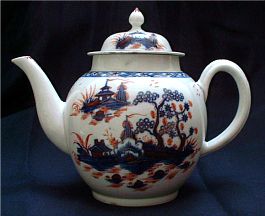 The
Featured Antique is a very fine example of an eighteenth century Worcester
teapot, dating from 1765-1770. It can be seen to be copying the popular oriental
export ware designs from China. Its decoration is in underglaze blue with orange
enamel embellishments giving a beautiful oriental scene of temples in enchanting
gardens. This scene is known as the Worcester cannon ball pattern, due to the
three balls at the bottom of the scene. These balls are actually a
representation of three mythical islands. This delightful globular teapot can be
viewed on the TeaAntiques website.
The
Featured Antique is a very fine example of an eighteenth century Worcester
teapot, dating from 1765-1770. It can be seen to be copying the popular oriental
export ware designs from China. Its decoration is in underglaze blue with orange
enamel embellishments giving a beautiful oriental scene of temples in enchanting
gardens. This scene is known as the Worcester cannon ball pattern, due to the
three balls at the bottom of the scene. These balls are actually a
representation of three mythical islands. This delightful globular teapot can be
viewed on the TeaAntiques website.
More details of this item and other tea related antiques can be found by visiting my web site at www.TeaAntiques.com.
This
month I decided to take a trip to Oxford, England's heart of knowledge and
learning. Oxford is famous for its collection of fine old established colleges
and University, where many famous scholars and political leaders from history
have been educated. Today, the town still retains an air of the 'old school', a
bustling, yet compact and sedate town alive with students soaking up their
education in a wide and diverse set of subjects.
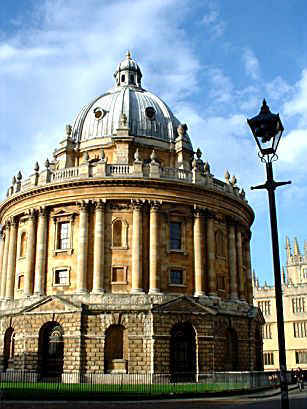
The first impression when approaching this beautiful town is the cluster of spires, towers and domes associated with the colleges and churches. These spires and towers which dominate the town's skyline is a view that must have remained much unaltered over the centuries. Indeed, many of the colleges' roots date back many centuries.
My trip today was not to visit or review the colleges - with their attractive buildings, fine architecture and quadrangles with what must be the greenest, well maintained grass lawns in England - but to visit the Ashmolean Museum.
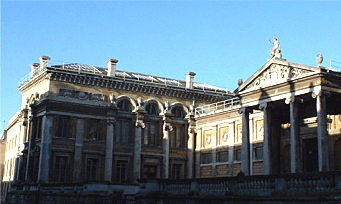 The
Ashmolean Museum is situated in the centre of Oxford and was established in 1683
(it is one of the oldest public museums in the world). It is housed in a
delightful neoclassical building with an impressive grand façade. Inside there
is a staggering array of artefacts, exhibitions and collections, from this and
other countries.
The
Ashmolean Museum is situated in the centre of Oxford and was established in 1683
(it is one of the oldest public museums in the world). It is housed in a
delightful neoclassical building with an impressive grand façade. Inside there
is a staggering array of artefacts, exhibitions and collections, from this and
other countries.
My visit was to look at their fine collection of eighteenth century porcelain and eighteenth century drinking glasses.
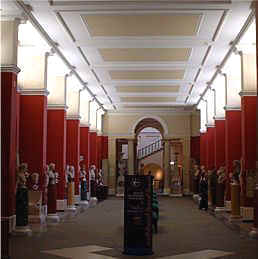 In
walking to the gallery devoted to a magnificent
In
walking to the gallery devoted to a magnificent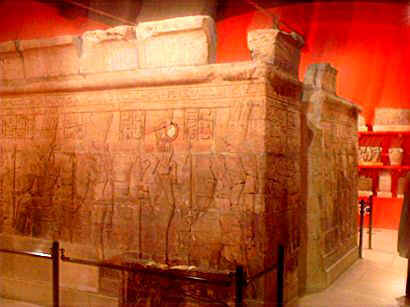 collection of eighteenth century porcelain, one walks through an impressive
sculpture gallery. There are many Roman classical sculptures on view set against
crimson red walls. The sculpture gallery is followed by an exhibition of
Egyptian artefacts including a complete Temple - The Shrine of Taharqa from the
25th Dynasty (712-657 BC).
collection of eighteenth century porcelain, one walks through an impressive
sculpture gallery. There are many Roman classical sculptures on view set against
crimson red walls. The sculpture gallery is followed by an exhibition of
Egyptian artefacts including a complete Temple - The Shrine of Taharqa from the
25th Dynasty (712-657 BC).
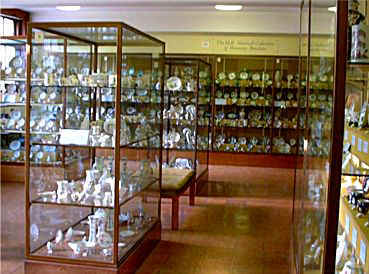 On
reaching the porcelain gallery I was quite amazed by the size of the collection
and the wealth of the exquisite examples on show. There were many cups and
saucers, teapots, tea canisters, teapot stands, plates, vases and much more
besides. An absolute haven for the collector of fine eighteenth century
porcelain, especially tea related wares. Much of the exhibition is devoted to
the famous English factories such as Worcester, Bow, Chelsea, Derby, etc. It
demonstrates the changes in design and decoration, clearly showing how the
decoration of porcelain in England copied the styles of other famous European
factories. Examples that copy the styles of Sevré and Meissen and Sevré or
following the examples of Chinese export wares can be seen.
On
reaching the porcelain gallery I was quite amazed by the size of the collection
and the wealth of the exquisite examples on show. There were many cups and
saucers, teapots, tea canisters, teapot stands, plates, vases and much more
besides. An absolute haven for the collector of fine eighteenth century
porcelain, especially tea related wares. Much of the exhibition is devoted to
the famous English factories such as Worcester, Bow, Chelsea, Derby, etc. It
demonstrates the changes in design and decoration, clearly showing how the
decoration of porcelain in England copied the styles of other famous European
factories. Examples that copy the styles of Sevré and Meissen and Sevré or
following the examples of Chinese export wares can be seen.
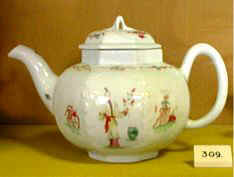
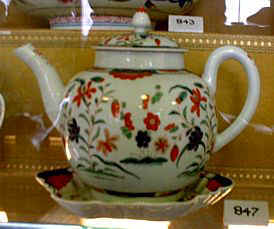
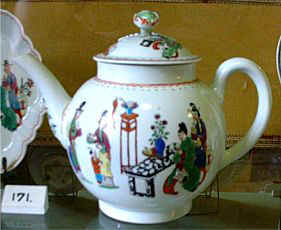
There are some truly delightful Worcester teapots and tea wares with various attractive ground colours of cobalt blue, green and turquoise. These are beautifully painted with delicate and brilliant floral sprays and sprigs, much in the taste of Meissen wares.
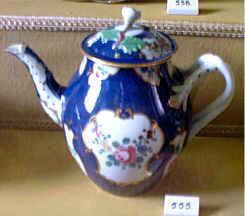
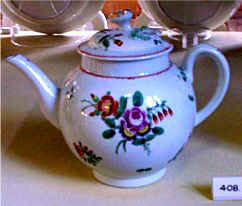
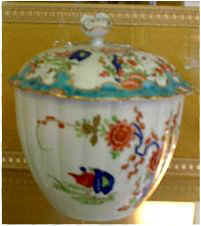
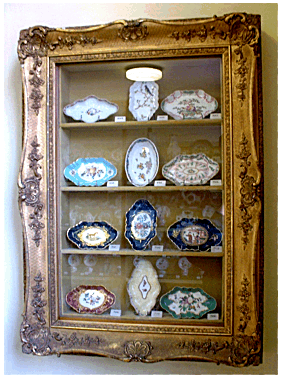
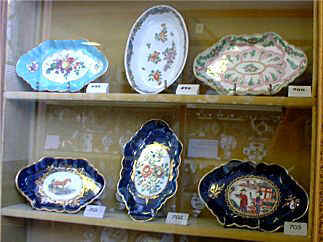 An
exhibit that I found most fascinating was a collection of rare spoon trays,
displayed on the wall in a large picture frame. Spoon trays were an important
and integral part of an eighteenth century tea equipage. These delightfully
shaped oval trays were necessary as the saucers of tea bowls at that period
were, like those from China, small and would not easily accommodate a teaspoon.
Therefore, spoon trays were required, one to each tea service on which tea
spoons and the mote spoon (used for unblocking the spout of the teapot and
skimming the 'motes' or leaves from the tea bowls), could be rested during the
tea ceremony. It is quite unusual to find such a beautiful collection of
delightful spoon trays and are a treat to behold. These little trays, only being
one per tea set, are rare as many have long since been broken. Sometimes oval
teapot stands are incorrectly identified and sold as spoon trays - so beware!
Generally, spoon trays are smaller than teapot stands and are more intricate in
their shape.
An
exhibit that I found most fascinating was a collection of rare spoon trays,
displayed on the wall in a large picture frame. Spoon trays were an important
and integral part of an eighteenth century tea equipage. These delightfully
shaped oval trays were necessary as the saucers of tea bowls at that period
were, like those from China, small and would not easily accommodate a teaspoon.
Therefore, spoon trays were required, one to each tea service on which tea
spoons and the mote spoon (used for unblocking the spout of the teapot and
skimming the 'motes' or leaves from the tea bowls), could be rested during the
tea ceremony. It is quite unusual to find such a beautiful collection of
delightful spoon trays and are a treat to behold. These little trays, only being
one per tea set, are rare as many have long since been broken. Sometimes oval
teapot stands are incorrectly identified and sold as spoon trays - so beware!
Generally, spoon trays are smaller than teapot stands and are more intricate in
their shape.
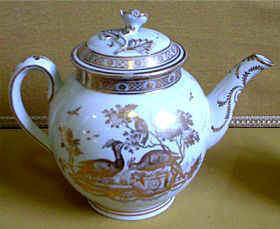
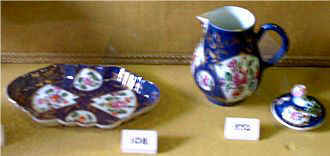
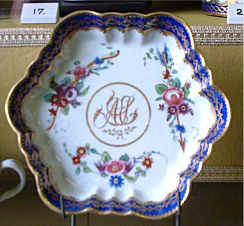
The porcelain gallery has so much to see for the connoisseur of eighteenth century fine porcelain, that it would be all too easy to spend a great deal of time here, examining items piece by piece. I certainly found that it took my interest for a great deal of time and still too much to appreciate fully in one visit.
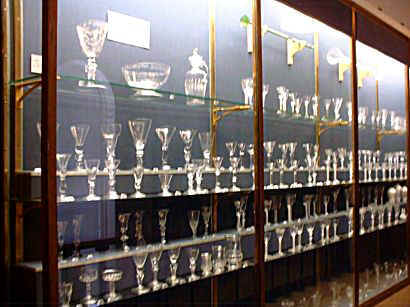 Eventually,
I dragged myself away from the fine china to go off in search of the collection
of eighteenth century drinking glasses. I located the collection housed in a
large glass cabinet on a landing at the top of one of the staircases. The
shelves of this huge cabinet were laden with a wide variety of magnificent
glasses taking you through the different styles that came about throughout the
eighteenth century.
Eventually,
I dragged myself away from the fine china to go off in search of the collection
of eighteenth century drinking glasses. I located the collection housed in a
large glass cabinet on a landing at the top of one of the staircases. The
shelves of this huge cabinet were laden with a wide variety of magnificent
glasses taking you through the different styles that came about throughout the
eighteenth century.
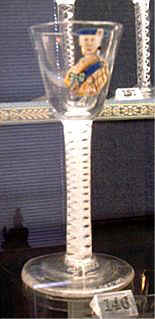
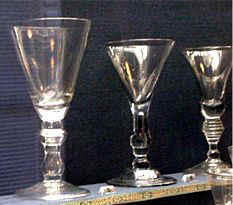 There
are some extremely rare and very fine early baluster stemmed glasses as well as
examples of engraved 'Jacobite' wine glasses, mixed colour, opaque and air
twisted stems, etc.
There
are some extremely rare and very fine early baluster stemmed glasses as well as
examples of engraved 'Jacobite' wine glasses, mixed colour, opaque and air
twisted stems, etc.
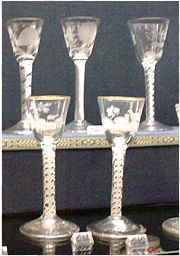 Of
particular note are some examples decorated by Beilby of Newcastle. These have
bowls decorated with delicate and fine white enamel scenes of various subjects.
Not only are these exquisite to see but are also very rare to find now (and
hence extremely expensive to buy-if you can find them!).
Of
particular note are some examples decorated by Beilby of Newcastle. These have
bowls decorated with delicate and fine white enamel scenes of various subjects.
Not only are these exquisite to see but are also very rare to find now (and
hence extremely expensive to buy-if you can find them!).
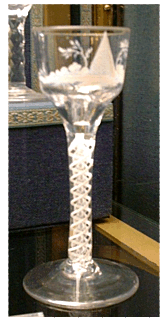
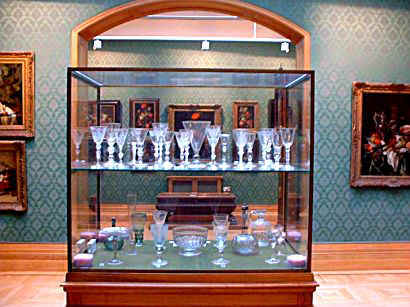
Details of the Ashmolean museum are as follows:
Ashmolean Museum
Beaumont Street (opposite the Randolph Hotel)
OXFORD OX1 2PH United Kingdom
Street Map (courtesy of www.streetmap.co.uk)
Tel: 01865 278000
Fax: 01865 278018
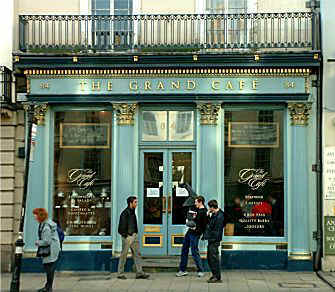
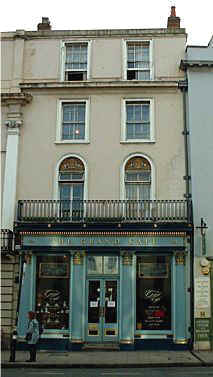 A
further attraction I discovered was in the High Street, where there is a café /
bar called 'The Grand Café' . It has a plaque on its wall that states is on the
site of the oldest Coffee House in England, opened in 1650.
A
further attraction I discovered was in the High Street, where there is a café /
bar called 'The Grand Café' . It has a plaque on its wall that states is on the
site of the oldest Coffee House in England, opened in 1650.
This is a most pleasant place in which to take lunch or afternoon tea. There is a very friendly and relaxed atmosphere, the café is very light, bright and a cheerful place in which to find oneself.
Tea
is served in old style 'hotel plate' silver plated teapots with paper napkins
neatly wrapped round the handles, which can be rather hot. On this visit, I was
too early to participate in their selection of traditional afternoon teas, which
start from 3:30. So I selected to go for one of their interesting sandwiches, my
choice was for a Chicken
Caesar
Salad Sandwich served on a very tasty rye bread.
They serve tea made from fine loose tea, rather than teabags and is of good quality.
They serve a Champagne, or high tea, which has a slightly unusual twist. Apart from the smoked salmon and cream cheese and egg sandwiches followed by traditional scones, cream and jam, they complete the tea with chocolate truffles instead of cake - the truffles go nicely with the Champagne!
The
café bar - with its high ceilings supported by marbled ionic columns, the walls
hung with large gilt frame mirrors and large potted elegant palms positioned
between the tables - is a fine retreat from the hustle and bustle of the High
Street.
Details
of The Grand Café are:
The Grand Café
84, High St
Oxford OX1 4BG United Kingdom
Street
Map (courtesy of www.streetmap.co.uk)
Tel: 01865 204463
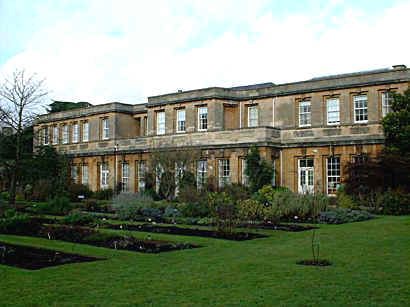 Finally,
after taking tea at The Grand, only a few minutes walk down the road are the
Botanical gardens. A relaxing place in which to stroll and where admission is
free. The gardens are quite small, bounded by the River Cherwell on its way to
join the River Thames, where in summer one can observe the punts gliding past.
There are also a couple of conservatories housing more tender plants, these are
ideal in which to take refuge in bad or cold weather! The gardens provide an
ideal place to walk off that afternoon tea, whilst enjoying their beauty.
Finally,
after taking tea at The Grand, only a few minutes walk down the road are the
Botanical gardens. A relaxing place in which to stroll and where admission is
free. The gardens are quite small, bounded by the River Cherwell on its way to
join the River Thames, where in summer one can observe the punts gliding past.
There are also a couple of conservatories housing more tender plants, these are
ideal in which to take refuge in bad or cold weather! The gardens provide an
ideal place to walk off that afternoon tea, whilst enjoying their beauty.
To review past newsletters, just follow this link:
Past newsletters.
To subscribe to this free newsletter -
Click here